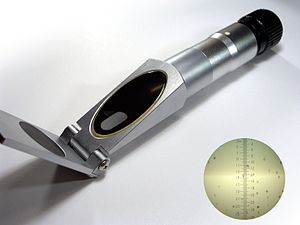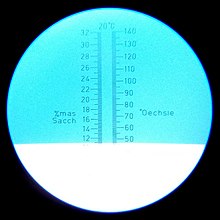Traditional handheld refractometer


A traditional handheld refractometer is an analog instrument for measuring a liquid's refractive index. It works on the critical angle principle by which lenses and prisms project a shadow line onto a small glass reticle inside the instrument, which is then viewed by the user through a magnifying eyepiece.
In use, a sample is placed between a measuring prism and a small cover plate. Light traveling through the sample is either passed through to the
bi-metallic strip that moves a lens or prism in response to temperature changes. This design was invented by Emanuel Goldberg. There are many types of refractometers and the most common types are Abbe's refractometer
, Pulfrich refractometer, Immersion refractometer.
